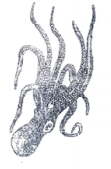The figure shows four animals (a), (b), (c) and (d). Select the correct answer with respect to a common characteristic of two of these animals:
| (a) |  |
(b) |  |
| (c) |  |
(d) |  |
1. (c) and (d) have a true coelom
2. (a) and (d) respire mainly through body wall
3. (b) and (c) show radial symmetry
4. (a) and (b) have cnidoblasts for self-defence
Which characteristic is true for Obelia?
1. Metagenesis
2. Morphogenesis
3. Apolysis
4. Pedogeny
Which of the following animals have scattered cells with cell–tissue grade organization:
1. Sponge
2. Hydra
3. Liver fluke
4. Ascaris
Match the following
| List-I | List-II | ||
| (a) | Physalia | i. | Pearl oyster |
| (b) | Limulus | ii. | Portuguese Man of War |
| (c) | Ancylostoma | iii. | Living fossil |
| (d) | Pinctada | iv. | Hookworm |
Choose the correct answer from the options given below:
| Options: | (a) | (b) | (c) | (d) |
| 1. | ii | iii | iv | i |
| 2. | i | iv | iii | ii |
| 3. | ii | iii | i | iv |
| 4. | iv | i | iii | ii |
Read the following statements.
| (a) | Metagenesis is observed in Helminths. |
| (b) | Echinoderms are triploblastic and coelomate animals. |
| (c) | Round worms have organ-system level of body organization. |
| (d) | Comb plates present in ctenophores help in digestion. |
| (e) | Water vascular system is characteristic of Echinoderms. |
Choose the correct answer from the options given below:
1. (a), (d) and (e) are correct
2. (b), (c) and (e) are correct
3. (c), (d) and (e) are correct
4. (a), (b) and (c) are correct
Metagenesis refers to?
| 1. | The presence of different morphic forms |
| 2. | Alternation of generation between asexual and sexual phases of an organism |
| 3. | Occurrence of a drastic change in the form during post-embryonic development |
| 4. | Presence of a segmented body and parthenogenic mode of reproduction |
Select the Taxon mentioned that represents both marine and freshwater species:
1. Echinoderms
2. Ctenophora
3. Cephalochordata
4. Cnidaria
| List I | List II | ||
| A. | Taenia | I. | Nephridia |
| B. | Paramoecium | II. | Contractile vacuole |
| C. | Periplaneta | III. | Flame cells |
| D. | Pheretima | IV. | Urecose gland |
| Options: | A | B | C | D |
| 1. | II | I | IV | III |
| 2. | I | II | III | IV |
| 3. | I | II | IV | III |
| 4. | III | II | IV | I |
| A: | Platyhelminthes are triploblastic, pseudocoelomate and bilaterally symmetrical organisms. |
| B: | Ctenophores reproduce only sexually and fertilization is external. |
| C: | In tapeworm, fertilization is internal but sexes are not separate. |
| D: | Ctenophores are exclusively marine, diploblastic and bioluminescent organisms. |
| E: | In sponges, fertilization is external and development is direct. |
Choose the correct answer from the options given below:
| 1. | (A), (C) and (D) only | 2. | (B), (C) and (D) only |
| 3. | (A) and (E) only | 4. | (B) and (D) only |
Match the following genera with their respective phylum :
| Column I | Column II | ||
| (a) | Ophiura | (i) | Mollusca |
| (b) | Physalia | (ii) | Platyhelminthes |
| (c) | Pinctada | (iii) | Echinodermata |
| (d) | Planaria | (iv) | Coelenterata |
Select the correct option :
| Options: | (a) | (b) | (c) | (d) |
| 1. | iv | i | iii | ii |
| 2. | iii | iv | i | ii |
| 3. | i | iii | iv | ii |
| 4. | iii | iv | ii | i |






